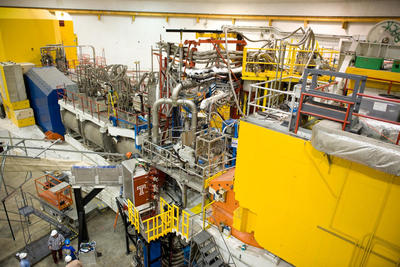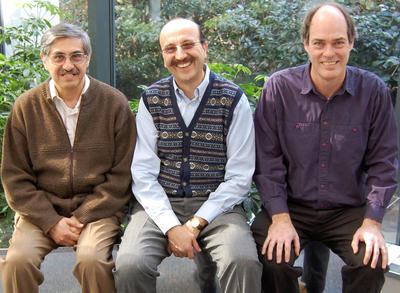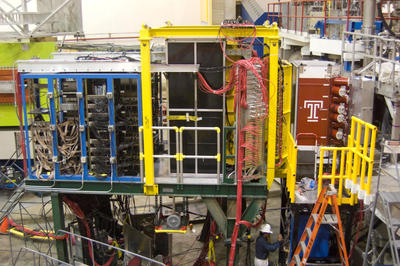
A view of the experimental hall during installation of the components of the Big Electron Telescope Array. The High Momentum Spectrometer (left in blue and yellow) and the new Cerenkov detector (red with "T") are being used in the experiment.
If you want to make a volcano erupt for a science demonstration, most parents know that adding a little vinegar to a solution of baking soda will yield a proper eruption. It's the interaction of vinegar and baking soda that makes the "lava" flow.
Now nuclear physicists are looking at how similarly bombastic interactions in the nucleus of the atom help to build matter.
They're looking at the interactions between quarks and gluons, the subatomic building blocks of protons and neutrons. Gluons are the "glue" that hold quarks together to build protons and neutrons. Physicists like to think of gluons as a physical manifestation of the strong force - one of the four forces of nature.
The study uses a modern subatomic microscope, the Continuous Electron Beam Accelerator Facility at Jefferson Lab. But while CEBAF allows scientists to probe quarks, it can't access gluons: It is currently impossible to view gluons directly using an electromagnetic probe.

SANE spokesmen take a break from the experiment. They are, from left, Oscar Rondon Aramayo (University of Virginia), Zein-Eddine Meziani (Temple University) and Mark Jones (Jefferson Lab). Not pictured is Seonho Choi (Seoul National University)
However, an intrinsic property of protons and neutrons, also called nucleons, may allow scientists tease out information about guark-gluon interactions. Every nucleon has spin, and it is a property that can be measured. In fact, researchers have already measured the total contribution of quark spin to the nucleon spin. They found that it takes more than the spin of the quarks to account for the nucleon spin.
"As you are looking for the spin of the total nucleon, it must come from the spin properties of each quark, because each quark has spin," explains Zein-Eddine Meziani. "But, you know, there are gluons there, and let us not forget the motion of both quarks and gluons in a confined volume."
Meziani, a professor of physics at Temple University, and his colleagues want to find out just how big a role the quark-gluon interaction plays in determining the properties of the proton. He is a co-spokesperson on the Spin Asymmetries of the Nucleon Experiment (SANE).
Meziani says the measurement isn't an easy one to make. The researchers send electrons from Jefferson Lab's CEBAF accelerator into a polarized proton (a proton with a spin direction transverse to the direction of the incoming electron beam) to strike the quarks.
"We scatter the electron off the quark with its spin orientation along that of the proton, which is then trying to get out, but as it's trying to get out, it feels the pulling force from the remaining system due to gluons. So that's called a quark-gluon correlation, and that's what we are after," Meziani elaborates.

The full installation of BETA. The aluminum frame of one hodoscope is visible to the right of the red Cerenkov detector. The second hodoscope is located between the Cerenkov detector and the BigCal spectrometer (black panels). An electronic readout with blue racks is located behind BigCal.
The experiment uses a special target that allows the experimenters to orient the spin of protons in the target in a chosen direction. The spin of the probing electrons from the CEBAF accelerator is also controlled - first oriented one way and then the opposite. The researchers will calculate the asymmetries -- the difference in their measurements as they flip the incoming electrons' spin -- to get information about the quarks.
In essence, the researchers are manipulating the spin properties of the particles to learn about how quarks and gluons interact.
"It's very interesting, because what you are accessing in this case is how much the quarks are seeing gluons inside: how much of this correlation contributes to this spin structure," Meziani comments. "So if we can pin down this picture, we can measure the average force of these gluons. In other words, the average force of this gluon acting on the struck quarks."
SANE collaborators will get their measurements from a newly installed apparatus built just for this experiment. The Big Electron Telescope Array (BETA) consists of two new hodoscopes, the BigCal spectrometer (which was used in a previous experiment), and a new Cerenkov detector.
While SANE is focused on making measurements of the proton, another experiment will make a complementary measurement of the same quantities for the neutron. That experiment has been running almost in parallel in Jefferson Lab's Experimental Hall A.
Spokespeople for both experiments expect to begin announcing results in the next two years.
About 90 physicists from 22 institutions are working on SANE, including six Ph.D. and M.S. thesis students.

